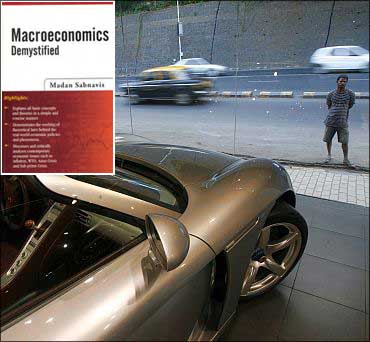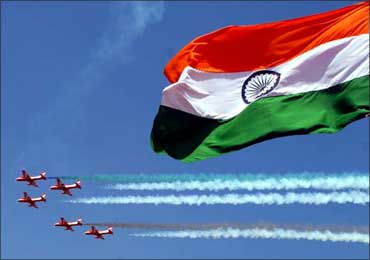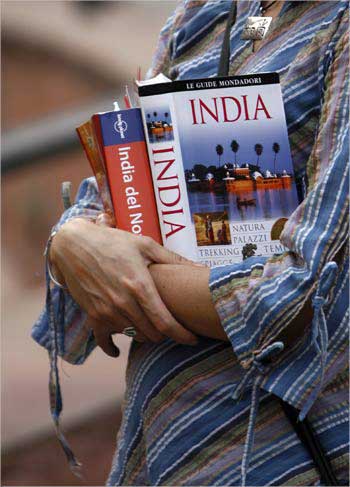 | « Back to article | Print this article |
Have India's reforms been a success story?
Have reforms been a success story?
This is a tricky question because there is a mixed response. If one were to choose between a 'yes' and a 'no', the answer would be yes.
The biggest gain has been the new structures that have been created which are for the better. In terms of direct material gains, the results have been exemplary as they were definitely not visible before the reforms period.
But, there has been a tendency to extol the major gains made in terms of growth and prosperity in the lives of the people after 1991.
Cheaper electronic goods, mobile phones, lap tops, shopping malls, fine dining, are some examples of the emerging India which could not have been visualized in the past by most of us.
Interest rates are globally aligned and it is possible to borrow for a vehicle very early in one's career. The same holds for mortgages and the extensive use of plastics in purchasing goods has already permeated the lower middle class while the farmers have also been brought into the fold with the farmer credit cards.
To the extent that the economic spheres that were sought to be subjected to reforms have succeeded significantly, one can be satisfied with the direction and pace of reforms.
While the benefits have been significant in terms of numbers as well as structural shifts that have taken place in the economy in the last decade and a half, there are some areas of concern.
Click NEXT to read on. . .
Excerpted from: Macroeconomics Demystified, by Madan Sabnavis. Reproduced with permission from Tata McGraw-Hill Publishing Company Limited. Price: Rs 295. Copyright 2008.
Have India's reforms been a success story?
The first is the area of agriculture. Reforms, as the reader may have noticed, have primarily been an urban oriented package covering industry and services in a restricted geography. This is a good beginning because most of the growth that takes place in the country is in these sectors and would hence tend to be concentrated in these areas.
These are the high impulse generating centers and are necessary to bring in the good numbers when it comes to growth. But, all the policies have aimed at improving productivity in industry and services, especially financial and have kept agriculture out of the purview.
The result has been an indifferent performance by the sector over the years, which, unfortunately affects a large part of the population.
The last attempt at changing the scope of agriculture was the Green Revolution that was seen in the seventies and very feebly in the eighties. This was a concerted action initiated by the government to improve yields in agriculture and was concentrated on use of better seeds, irrigation and fertilizers to uplift production.
It was also supported actively by the credit system as the banking system had gone through the nationalization phase to become more farmer oriented.
However, the Green Revolution ran into problems of indifference after a point of time. Given the nature of the package, it tended to get concentrated more in the northern states of Punjab, UP and Haryana and also got restricted to wheat. Hence, it was more of a wheat revolution rather than a green one.
The other states and the major crop, rice got left out in the process. Nevertheless, this was a significant achievement in this field. The problem of the exclusion of agriculture has meant that a major part of the GDP which covers a large part of the population given that 60% of the work force depends on agriculture for a living, has been left out.
Click NEXT to read on. . .
Have India's reforms been a success story?
The second major lacuna is the skewed nature of growth that has taken place. The rich have tended to become richer and the size of the middle class has increased. But, there is a mixed view on the poor.
The government numbers vary with the private estimates on the poor and the definition of poor by itself is quite nebulous. The World Bank defines poor as one who earns less than a dollar a day, which works out to around Rs 40 a day or Rs 1,200 a month at the exchange rate of Rs 40 per dollar.
Intuitively, one can look around your own house and see that there are several of or domestic help who have extended families running into 6-8 members who earn less than this amount and are actually poor, though they may not get included here.
Further, there have been several instances of starvation deaths and suicides by farmers who are unable to repay loans. Certainly, these instances do lend the thought that reforms have been skewed in terms of their positive effects.
Curiously, a government report recently brought out reveals that there could be 80% of the population that earns less than Rs 20 a day.
While these numbers are debatable and there would be naturally two views, what is important to note is that there is still a bridge between the rich and poor, which may have become a bit more distant.
The advantage of a large, growing middle classis that it camouflages to a large extent the overall misery levels since it holds out promise of hope for the poor as it moves along the income echelons.
Click NEXT to read on. . .
Have India's reforms been a success story?
The third area that has been addressed though not sufficiently to make an impact is the infrastructure sector.
While there have been efforts to bring in a modicum of privatization in the aviation industry and foreign investment in the power sector, large gaps exist which can be a barrier to growth. The pace of infrastructure growth has just not kept pace with the industrial growth rate thus creating a disconnection between the two.
Power supply remains erratic and scarce in several states. The state of roads is unsatisfactory despite all the efforts that have been put in, with only the highway work being commendable and the golden quadrilateral work in full progress.
Ports are in a state of regress with the average turn around time being 5-10 times higher than those in Singapore or Hong Kong. The problem is really of investment and while foreign investment is the clue, the actual inflow is much lower than what China for instance procures, which has helped them to steer the economy to a different level.
Also, rural infrastructure which is an integral part of the country's development is in an even worse state with there being little attention paid to roads, transport system, irrigation, power supply, drinking water, etc.
Click NEXT to read on. . .
Have India's reforms been a success story?
Closely related to these lacunae is the limited progress in social infrastructure encompassing education, sanitation, drinking water and health facilities. The progress has been abysmal and while there are announcements of certain allocations in every budget announced by the central and stage governments, the actual fructification of funds into these facilities has been limited.
This is why India still scores quite poorly under the social indicators by global agencies such as the World Bank.
So it does appear that the impact of reforms has been quite mixed and there is need to address these issues to eschew difficulties going ahead. The inequality part is critical because it can lead to social problems at a later date with the gap between the 'haves' and 'have-nots' increasing.
Given the vast population and the absolute number of deprived people, the task is clearly to address the issue head-on though some direct action programs. The infrastructure issue is more tickling because large quantities of funds are needed to improve the current state of our roads, ports, airports and power systems.
There are significant leakages that work against this development. If not tackled, they would serve as a physical barrier to economic growth because the country has already reached its peak level with the existing infrastructure.
Click NEXT to read on. . .
Have India's reforms been a success story?
Agriculture is another worry because there are really no solutions in the short run given the uneven structures that exist across developed and developing countries.
Agriculture is heavily subsidized in the west, which exposes our agriculture to certain disadvantages. To top it all, there is some degree of callousness in or approach, which has ignored agriculture and which is bound to create deeper problems as we move ahead. A long-term policy is essential to uplift the system.
Taking a balanced view of the entire process of reforms it may be said that we do have the platform from whence one can build on the foundation and try for inclusive growth.
The two processes have to move together to prevent lopsided growth and ensure that the distribution aspect of the development process is fully attended to.
Excerpted from: Macroeconomics Demystified, by Madan Sabnavis. Reproduced with permission from Tata McGraw-Hill Publishing Company Limited. Price: Rs 295. Copyright 2008.





